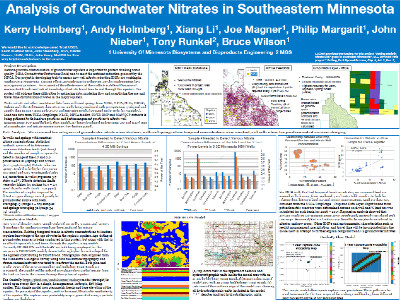Reducing nitrate contamination of groundwater aquifers is important to protect drinking water quality (MDA Groundwater Protections Rule) and to meet the nutrient reduction goals set by the MPCA. The MPCA goals are for 25% nitrate reduction for 2025 and a 45% nitrate reduction by 2050. Our project is developing tools to assess how well nitrate reduction BMPs are working in southeastern Minnesota. This poster is focused on nitrate concentrations in groundwater in the karst region of southeastern Minnesota.
We examined two categories of nitrate groundwater concentrations, wells and springs where temporal concentrations were constant, and wells where temporal concentrations were changing. In wells and springs with constant nitrate concentrations, statistical methods were used to determine minimum detection limits and the number of samples required to detect a change. Nitrate values in springs tended to be higher and vary significantly more than in wells. Nitrate detection limits were also higher for springs (0.9–2.5 ppm) than for wells (0.16–2.0 ppm). The number of samples required to detect a 1 ppm change varied greatly by groundwater source with wells averaging 13 (range 2–60) samples and springs averaging 52 (range 34–79) samples. For wells that had temporal trends in nitrates, we examined land use around the wells to look for relationships between land use and nitrate concentration. Land use data was obtained from the USDA CropScape – Cropland Data Layer. Input basins were determined around each well and percent land use was calculated for each basin for 2006–2017. Regression analysis showed that average yearly nitrate concentrations were highly correlated with perennials and row crops. Perennials were significantly negatively correlated with nitrate concentrations, while row crops were positively correlated. Other BMPs will be incorporated into the model next in attempt to further explain temporal trends in groundwater nitrates.
Speaker(s)
Kerry Holmberg, Andy Holmberg, Xiang Li, Joe Magner, Philip Margarit, John Nieber, Bruce Wilson, University of Minnesota Biosystems and Bioproducts Engineering; Tony Runkel, Minnesota Geological Survey
